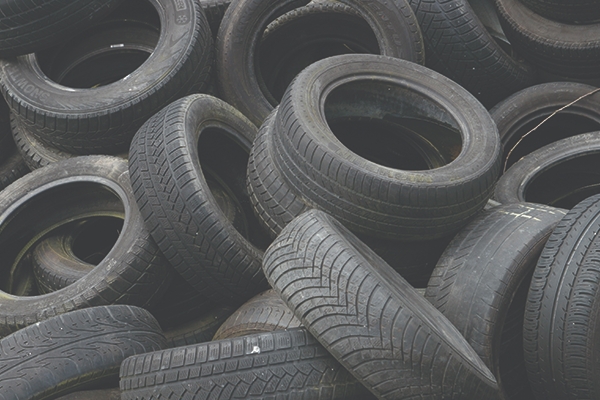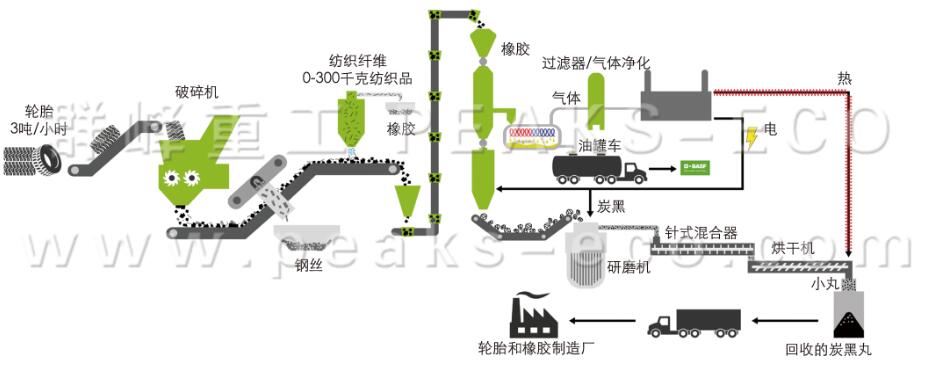"Green development is the background color of high-quality development, and the new quality productivity itself is green productivity." In recent years, Qunfeng Heavy Industry has implemented the "6G" green development concept, and is committed to becoming a leader in green manufacturing.

With the rapid development of the automobile industry, the production of used tires is increasing, as industrial hazardous waste, it will cause damage to the natural environment and vegetation growth. As the world's most populous country, China is also a giant in rubber consumption. In the era of advocating low-carbon economy, so the recycled rubber came into being, make full use of China's rubber recycling resources, alleviate the shortage of rubber resources, protect the ecological environment, take the road of circular economy, for our country has far-reaching strategic significance.
Comprehensive utilization of waste rubber is an important link in the complete upstream and downstream industrial chain of the rubber industry, and it is also an indispensable step in the green renewable recycling of the whole life cycle of the rubber industry. In the current context of China's "3060 Carbon Peak Carbon Neutral", there is still a lot of work that can be done in the comprehensive utilization of waste rubber branch, the industry also has a lot of potential to be tapped, and I hope that the industry enterprises are widely united to further promote the sustainable and healthy development of the industry.
Waste vulcanized rubber after crushing, heating, mechanical treatment and other physical and chemical processes, from the elastic state into a plastic and viscous, able to revulcanize the rubber. The regeneration process of waste rubber is called "desulfurization", which is a reaction process opposite to the vulcanization reaction, but it is not to separate the combined sulfur in the vulcanized rubber from the rubber molecules, nor to make the structure of the rubber molecules completely restored to the state of the raw rubber, but to make the vulcanized rubber partially degraded, destroying the original mesh structure, so as to make the vulcanized rubber plasticity to be restored to a certain extent. Certain recovery. The essence of the regeneration process is in the heat, oxygen, mechanical action and regeneration of chemical and physical effects of the agent under the combined effect, so that the vulcanized rubber network damage degradation, fracture location both crosslinked bonds, but also between the crosslinked bonds between the macromolecular bonds. From the point of view of the mechanism of desulfurization, desulfurization extruder is to achieve two sections of a short period of time (2-3 minutes) desulfurization, the front section is a high-temperature oxidation of the chain, the temperature can reach 240 ℃ or more, to achieve high-temperature oxidation of the regeneration; after the section is a mechanical low-temperature shear, forcing the chain to break to achieve the low-temperature mechanical force regeneration. At the same time, the use of a small amount of regenerant accelerates the regeneration process.
In the unique and patented pyrolysis process of Peaks-eco, secondary raw materials from tires are obtained in an environmentally friendly way.
In a Peaks-eco pyrolysis plant, rubber granules are broken down in the absence of oxygen into other valuable secondary raw materials: coke or rCB (Recovered Carbon Black) for the rubber and plastics industry, crude oil and natural gas for the chemical industry. In our tire pyrolysis plants, the gas obtained is converted into electricity in a cogeneration plant. This makes the entire recycling plant energy self-sufficient.

Pyrolysis of waste tires is an incomplete thermal degradation process carried out in an oxygen-poor or aggressive atmosphere that produces liquid and gaseous hydrocarbon compounds and carbon residues, which can be further processed and transformed into high-value products with a variety of uses.
Pyrolysis technology is an industrialized production technology with a long history, and is used in a large number of applications for the processing of fuels such as wood, coal, heavy oil, and oleaginous shale. Wood can get charcoal by pyrolysis dry distillation; coal with coking coal as the main component can get coke by pyrolysis carbonization; gas coal and semi-coke can get coal gas by pyrolysis vaporization; heavy oil can be pyrolysis vaporized; and oleaginous shale can get liquid fuel products by low-temperature pyrolysis dry distillation. Among the above processes, the coke oven pyrolysis carbonization technology is the most mature and has the widest range of applications.
Although pyrolysis technology has been successfully applied in the production of coke from bituminous coal since a long time ago, the research on pyrolysis technology for municipal solid waste did not begin to receive attention and emphasis until the 1960s, and the pyrolysis treatment of solid waste was only practically applied in the early 1970s. After pyrolysis treatment of solid waste, in addition to obtaining fuel and chemical products that are easy to store and transport, the charcoal residue obtained under high-temperature conditions will also constitute a hard and brittle inert solid product with certain inorganic and metal components in the material, making the subsequent landfill disposal operations safer and more convenient.
Practice has proved that pyrolysis treatment is a promising solid waste treatment method, which is suitable for the treatment of municipal garbage, sludge, waste plastics, waste resins, waste rubber and other treatment, as well as agricultural and forestry wastes, human and animal feces, and other organic solid wastes with a certain amount of energy treatment.
Waste tire pyrolysis treatment technology can effectively recover carbon black, aromatics-rich oil and high calorific value fuel gas through conversion, realizing the maximum recovery of energy and full reuse of waste tires, with high economic and environmental benefits, and at the same time, it has the characteristics of large treatment capacity, high efficiency and low environmental pollution. Pyrolysis technology is an important method for resource treatment of waste tires (passenger car tires) today.
At present, pyrolysis equipment in China is broadly divided into two categories: one is rotary kiln, which belongs to intermittent production, feeding, discharging open operation, dust, odor emission, low degree of automation; the other is continuous pyrolysis device, feeding, pyrolysis, discharging closed operation, isolated from the outside world, no dust and odor, non-condensable cocoa gas into the combustion system to fully combust, the combustion system of the exhaust generated by the treatment of the organized emissions, but the equipment investment is large. The waste gas produced by the combustion system is treated and discharged in an organized manner, but the investment in equipment is large.
Waste tire pyrolysis can get 45% ~ 50% pyrolysis oil, 32% ~ 36% carbon black and 12% ~ 15% steel wire (waste tire pyrolysis products see Figure 2), these pyrolysis products have their own uses. Pyrolysis carbon black mainly comes from the tire production process to add carbon black and other inorganic fillers, as well as pyrolysis process due to the secondary reaction caused by the coking reaction and the formation of some of the coke deposited on the surface of the pyrolysis carbon black coke material. Pyrolytic carbon black is a black solid and can be easily pulverized into a powdery substance. As the yield of pyrolytic carbon black is high, its quality will have an important impact on the economic benefits of the pyrolysis process. High-quality pyrolytic carbon black products will even be far more profitable than pyrolytic oil. Pyrolytic carbon black is used as carbon black or made into activated carbon after activation has a high value of use.
Rubber regeneration is different from reuse, regeneration is to make the material change its composition through chemical reaction to get new materials or new base materials, these new materials can be used in the same or completely different application scenarios as the previous application. Currently, the main focus is on rubber de-crosslinking and deep recycling.